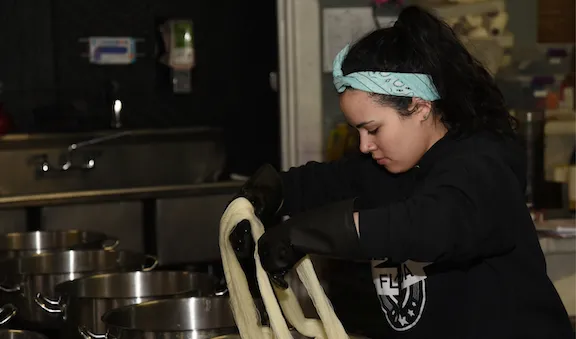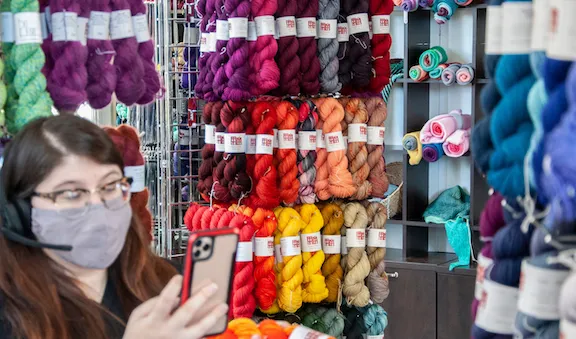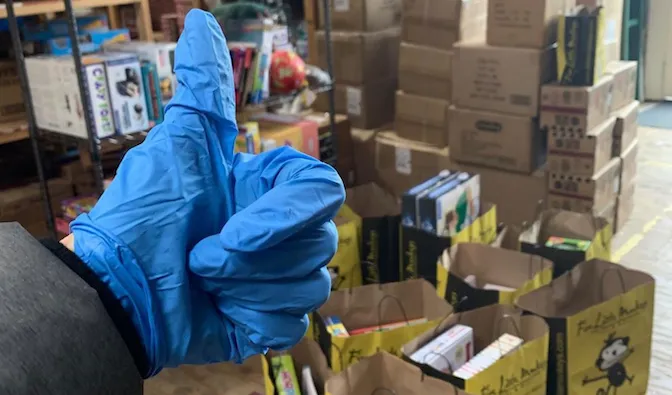Table of contents
COVID-19 is changing the way stores do business, prompting an accelerated shift to online sales and services like curbside pickup, delivery, and virtual experiences.
Customers are embracing these new shopping options for their safety and convenience, giving retailers more ways to interact. But to offer a successful omnichannel retail experience, it’s not enough to just show up on these channels. Each channel needs to work together to create a unified, consistent experience for your customers.
Whether you focus on eCommerce sales, in-store experiences, or a mix of both, you want your customers to recognize your brand inside every interaction. The service customers receive in-store should translate across your online store, social media channels, and delivery platforms.
We spoke with two business owners about how they train their teams to engage with shoppers across five important channels.
Match your service with customers’ needs
Stephanie Sala is the owner of Five Little Monkeys, a specialty toy and gift store with six locations in Northern California. Sala holds weekly video calls with her team to train them on how to engage with customers during such an unusual time.
For example, Sala goes over safety protocols and the various ways her staff can best help customers. Some customers want a contactless environment where staff members touch the products for them, while others prefer to be left alone to browse. Sala trains employees on how to match their service with each customer’s comfort level and needs.
The Five Little Monkeys team in their warehouse.
It’s important to look beyond your normal business operations, too.
To evolve the in-store experience, Sala checks in with other toy store owners from across the country and attends webinars hosted by retail experts to see how they’re innovating. She also asks her staff for their input on these new ideas, asking them to draw from their personal shopping experiences during COVID-19.
“My staff members have great ideas and are on the front lines with customers,” said Sala. “Sometimes they offer a perspective I hadn’t thought of. When I involve them, they are more invested in the company’s success.”
Help employees brush up on product knowledge
To provide a positive in-store experience, your staff needs to know about the products they sell. That way, your employees can give customers the information they need to make informed purchasing decisions, no matter where they are.
In addition to training staff on customer needs, Sala also stresses the importance of educating the team on what you’re selling and how those products show up on each channel.
“Encourage staff to familiarize themselves with your website so they can know how to answer customer questions,” Sala said. Consider asking your team to visit specific sections of your website, and then talk through any questions they would imagine first-time or repeat customers having about individual products and the online shopping experience in general.
Make online operations a part of your training
Karida Collins, the owner of Neighborhood Fiber Co., sells hand-dyed yarn for knitters, crocheters, weavers, and other makers. When the pandemic closed her store in Baltimore, Maryland, she quickly pivoted her attention and efforts to online channels.
Collins posted on her Facebook and Instagram pages, telling customers her shop was closed but her online store was open, and sent an email to her subscribers. She also offered curbside pickup and free shipping on domestic orders. Communication is key, found Collins. So if customers aren’t ready for in-store shopping, it’s important to direct them to the other places they can find you, like your online store or social media profiles.
All of that work paid off. “I didn’t want to lay off employees and decided we had to figure out a way to stay open,” Collins said. “Our online yarn sales never slowed down, and June was the busiest month we’ve ever had.”
An employee dying yarn at Neighborhood Fiber Co.
Besides dying yarn, Collins trains every employee at Neighborhood Fiber Co. to handle each aspect of the business. Before the pandemic, employees had set responsibilities. But when her online sales increased, employees who previously handled production work shifted to fulfilling online orders.
Since they were cross-trained, employees could provide the same level of service customers expected across all channels.
Turn social outreach into sales opportunities
You can also turn your social media profiles into eCommerce channels. Collins embeds her Instagram feed on the homepage of her online store, to easily help customers engage with her business across platforms.
Sala creates Facebook and Instagram content to support her products and give customers a better feel for the items she carries. For example, Sala and her team regularly feature educational toys that enhance distance learning, making her posts relevant for what customers are currently experiencing.
Get your staff involved by making sure they know what’s being featured on your social media pages so they can quickly and accurately answer questions. And since you may experience a higher volume of questions online because of social distancing, ask a member of your team to be responsible for checking those pages for customer questions and feedback.
Train your employees to respond promptly and professionally by putting together a list of sample responses to common customer questions, and provide feedback on their responses. Other customers watch how you interact on these public forums, so it’s important to provide the best possible service.
Build a virtual community
When nonessential businesses were forced to close at the beginning of the pandemic, some business owners took their services online using video conferencing. Appointment-based shopping sessions, workshops, and consultations continue to provide a way to stay connected to customers who aren’t comfortable visiting a physical location.
When Collins’ yarn store was closed to the public, she re-created the in-person feeling by offering virtual shopping sessions. “We told customers in an email that you can call us to talk about a project or schedule a Zoom shopping session,” she explained.
When shifting to virtual offerings, make sure your technology can support it. You’ll want to maintain that feeling of connection, so be sure that staff members who lead sessions are trained on the technology and have the right setup.
Virtual shopping appointments at Neighborhood Fiber Co.
Collins upgraded to an iPad Pro, which has a camera on both sides to be front- or rear-facing. This allows associates an easier way to walk through the store with customers and show them a variety of available products. She also provided employees with iPhone 11 Pros, which have a higher-quality camera compared to older models.
“When we’re selling to customers, we want to offer the best possible experience,” she said. “We sell color, and visuals matter.”
Don’t forget about delivery
Getting your products into customers’ hands isn’t just about logistics; it should also match your brand. So if your in-store shopping experience is based on speed and convenience, your delivery logistics should mirror that.
Invest in different forms of order fulfillment, like local delivery, shipping, and same-day curbside pickup. Giving customers options helps them choose the most convenient fulfillment method.
Offering multiple ways for customers to buy from you is particularly important this holiday season, considering the growing concern over shipping delays and supply chain issues, especially in the toy industry.
Sala instructs her team to encourage customers to shop early this year, by promoting holiday gift wrapping, offering free local delivery, and posting shopping reminders on social media. “Supply lines have been disrupted and we are trying to avoid having crowds come in December,” she explained.
The Five Little Monkeys team fulfilling online orders.
Another important aspect of delivery is your branding. Even if customers don’t set foot in your store, they should feel a connection to your business when they open their packages at home. Collins suggests including your company branding in every method and touchpoint. For example, she includes small trinkets and gifts with online orders to help make the experience special.
Every online order from Neighborhood Fiber Co. includes a small gift.
“Branding has always been a huge part of my vision for the company,” said Collins. “I had a logo before a product. I do my best to brand everything.”
The omnichannel experience starts with your team
With customers reaching out across more channels than ever before, creating an omnichannel plan for your business is essential. And your team is at the heart of that plan.
Employees who are well-trained and well-informed can help you deliver a more connected shopping experience everywhere your business shows up.
![]()
















